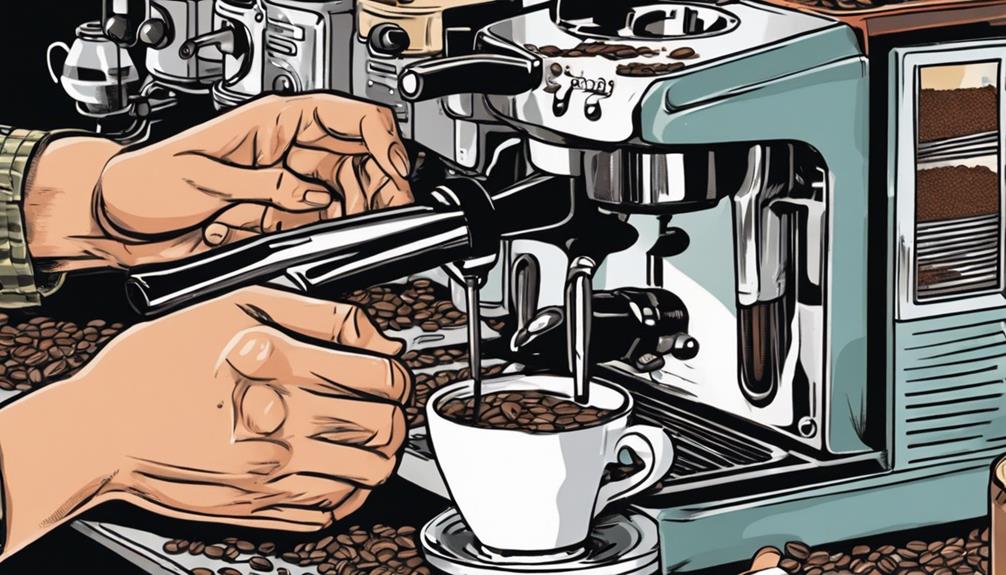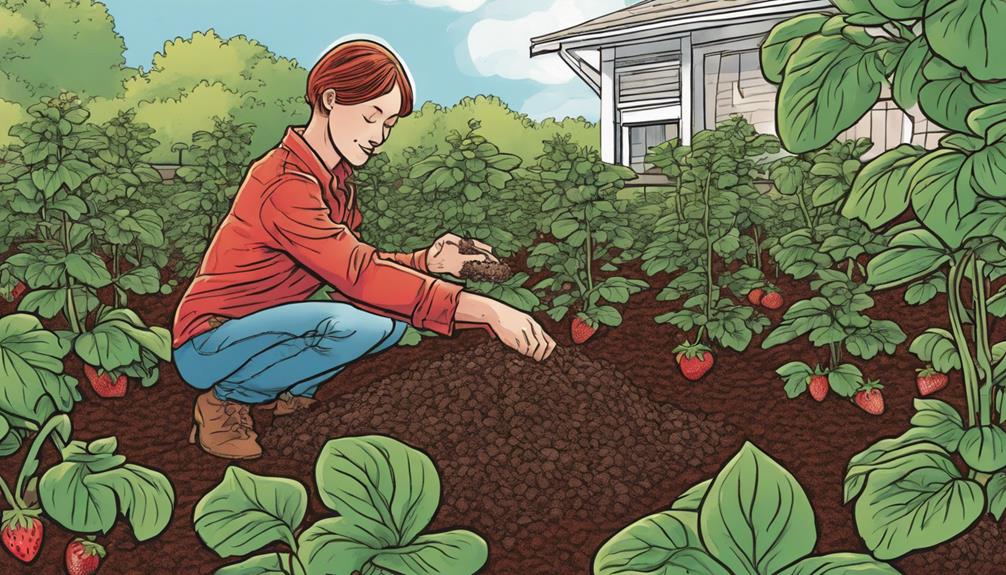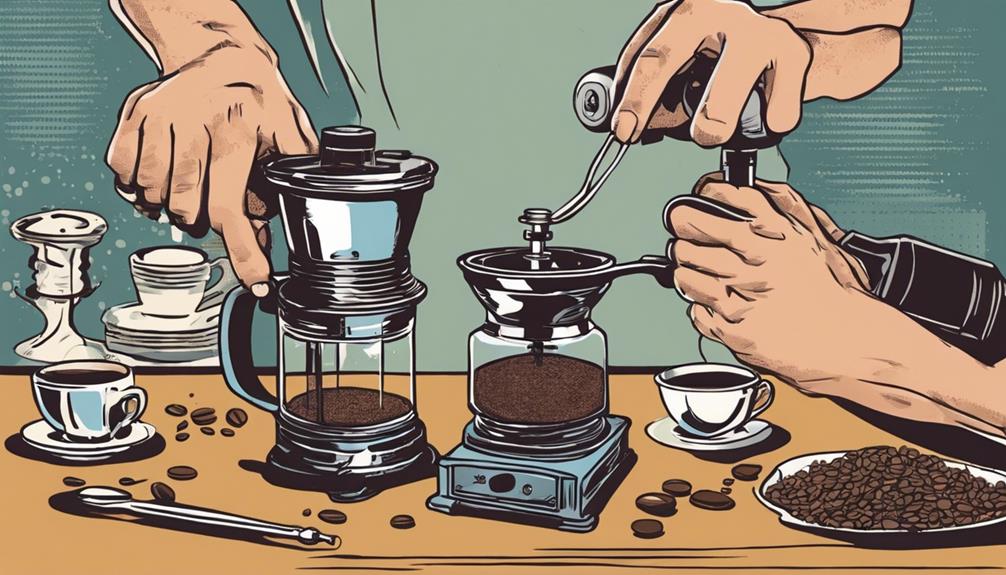To prepare the perfect cup of coffee at home, mix instant coffee powder, sugar, and hot milk in a deep cup. Beat vigorously for 5 minutes until creamy. Be careful not to add too much hot milk. Pour the mixture into clear glass mugs and top it with frothy hot milk. You can use a whisk or hand-held frother for this step. For an even frothier experience, consider using a bubble maker. By following these steps, you can enjoy a rich and creamy coffee treat that is comparable to any cafe. Master this technique and take your coffee game to the next level!
Key Takeaways
- Use instant coffee powder, sugar, and hot milk for beaten coffee.
- Vigorously beat the mixture for 5 minutes for a creamy texture.
- Avoid adding excess hot milk to maintain the desired consistency.
- Transfer the mixture to cups and pour hot milk for froth.
- Consider using a whisk or hand-held frother for optimal results.
Beaten Coffee Recipe
To make beaten coffee at home, all you need is instant coffee powder, sugar, and hot milk. The process of creating this delightful beverage involves vigorously beating the hot milk, sugar, and coffee powder until a creamy and frothy texture is achieved. The hot milk helps dissolve the instant coffee powder and sugar, creating a rich and flavorful base for the beaten coffee.
Beating the coffee mixture for at least 5 minutes is essential to reach the desired creamy consistency that characterizes beaten coffee. This method doesn't require any special appliances; all you need is a whisk or a hand-held frother to create the frothy goodness.
Beaten coffee offers a simple and cost-effective way to enjoy a cafe-quality coffee in the comfort of your home. By mastering this easy recipe, you can treat yourself to a delicious cup of beaten coffee anytime you crave that creamy and indulgent cappuccino-style coffee experience.
Step-by-Step Preparation Guide
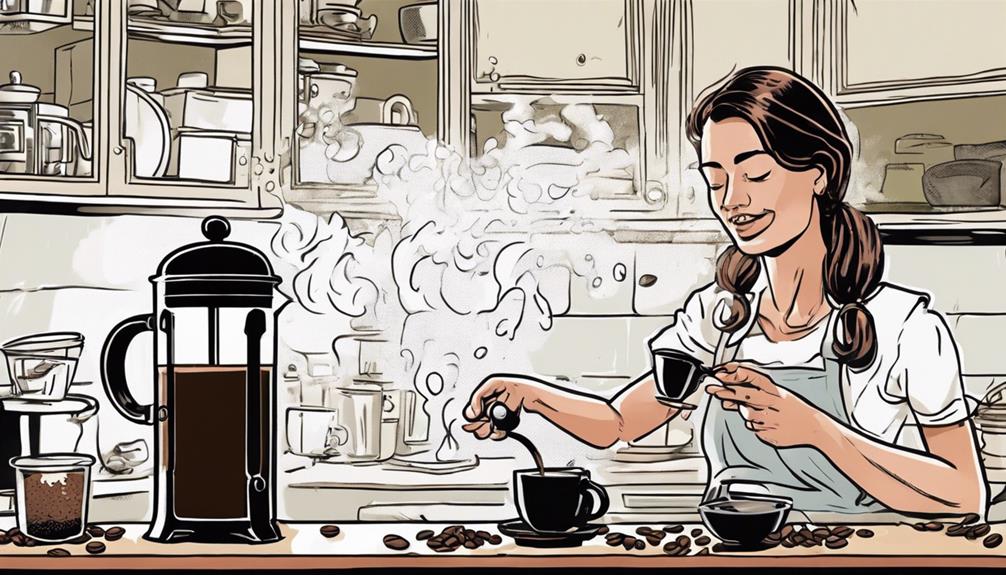
Now, let's get down to preparing your perfect cup of beaten coffee at home.
First, master the preparation technique to achieve that creamy texture you crave.
Then, we'll discuss serving recommendations to elevate your coffee experience.
Preparation Technique
For a creamy and frothy homemade coffee, start by using a deep and tall cup to mix coffee powder, sugar, and hot milk. Beat the mixture for at least 5 minutes until it becomes thick and creamy in consistency. Avoid adding excess hot milk to prevent the coffee from becoming runny. Once the mixture is creamy, transfer it to cups and pour hot milk over it to create froth. For extra froth, consider using a bubble maker before mixing it with the coffee.
| Step | Instructions |
|---|---|
| 1 | Mix coffee, sugar, and hot milk in a deep cup. |
| 2 | Beat the mixture for 5 minutes until creamy. |
| 3 | Transfer the creamy coffee to cups. |
| 4 | Pour hot milk over the mixture to create froth. |
Serving Recommendations
Consider presenting your creamy and frothy homemade beaten coffee in clear glass mugs to display its rich texture and layers of flavor. After beating the coffee mixture to a creamy consistency, pour it into the glass mugs.
Make sure to heat the milk separately until it's hot, and then carefully pour it over the beaten coffee to create a beautiful froth on top.
For an extra touch of frothiness, you can use a bubble maker to enhance the froth layer. Using a deep and tall cup for mixing the coffee powder, sugar, and hot milk initially is crucial.
Be sure to beat the mixture for a minimum of 5 minutes to achieve the perfect creamy texture.
Recommendations for Pairing

When pairing your beaten coffee, consider the delightful combination with fig muffins or the unique flavors of air fryer potato skin fries.
Enhance the experience by spreading garlic herb butter on toast, or indulge in a sweet treat with homemade white chocolate raspberry cheesecake.
Experiment with different food pairings to discover the perfect match for your beaten coffee enjoyment.
Pairing With Pastries
Enhance your beaten coffee experience by exploring delicious pairing options with pastries and treats. When enjoying your morning cup of beaten coffee, consider complementing it with a side of fig muffins for a perfect blend of sweetness and warmth. If you're in the mood for something savory, try pairing your beaten coffee with a serving of air fryer potato skin fries for a satisfying snack that will elevate your coffee break. For a more indulgent experience, accompany your beaten coffee with a side of garlic herb butter to enhance the rich and aromatic flavors of your brew. Additionally, if you're craving a sweet treat, opt for a white chocolate raspberry cheesecake to create a perfect balance of flavors that will elevate your coffee-drinking experience.
| Pastries/Treats | Description | Pairing Suggestion |
|---|---|---|
| Fig Muffins | Sweet and warm, perfect for a morning treat | Beaten Coffee |
| Air Fryer Potato Skin Fries | Savory and satisfying, ideal for a snack | Beaten Coffee |
| Garlic Herb Butter | Rich and aromatic, enhances the flavor of your coffee | Beaten Coffee |
| White Chocolate Raspberry Cheesecake | Perfect balance of flavors, indulgent treat | Beaten Coffee |
Complementing Snack Ideas
Discover delectable snack pairings that will elevate your beaten coffee experience and tantalize your taste buds.
Pair your delicious beaten coffee with fig muffins for a delightful breakfast or snack combination. The sweetness of the figs in the muffins will harmonize perfectly with the rich flavors of your coffee, creating a truly satisfying experience.
For a savory twist, try enjoying your beaten coffee with a side of garlic herb butter. The savory notes of the garlic and herbs will complement the boldness of your coffee, adding a new dimension to your morning routine.
Experiment with different snacks and treats to find the perfect pairing for your homemade beaten coffee. Whether it's air fryer potato skin fries for a crispy accompaniment or a white chocolate raspberry cheesecake for a decadent dessert, there are endless possibilities to enhance your coffee-drinking experience.
Treat yourself to these delightful combinations and savor every sip of your beaten coffee.
Beverage Accompaniments
Consider pairing your beaten coffee with a variety of delectable food accompaniments to elevate your drinking experience and tantalize your taste buds.
For a delightful breakfast or snack combination, try enjoying your beaten coffee with fig muffins. The sweetness of the figs complements the rich flavors of the coffee, creating a harmonious blend of tastes.
If you prefer a savory option, indulge in air fryer potato skin fries alongside your beaten coffee. These crispy and flavorful fries are the perfect accompaniment for a satisfying and comforting pairing with your beverage. The combination of the earthy potato skins and the bold taste of the coffee will surely satisfy your cravings.
Experiment with these suggestions to enhance your beaten coffee experience and discover new flavor profiles.
Whether you opt for the sweet fig muffins or the savory potato skin fries, you can elevate your coffee ritual with these delightful accompaniments.
Outdoor Life Contest Details

Details concerning the Outdoor Life Contest remain undisclosed, leaving readers curious about the requirements, prizes, participation guidelines, and theme. Without this essential information, aspiring participants are left in the dark about what's expected of them and what they could potentially gain from entering the competition.
The absence of a clear theme also adds to the mystery surrounding the contest.
- Prize details and value are unknown.
- Requirements for entry haven't been specified.
- The theme or focus of the contest remains a secret.
Hopefully, the contest organizers will soon reveal the missing pieces of information, allowing enthusiasts to prepare adequately and participate with enthusiasm.
Keep an eye out for updates on the Outdoor Life Contest to make sure you don't miss the chance to showcase your outdoor skills and potentially win exciting prizes.
Make It Resilient Challenge
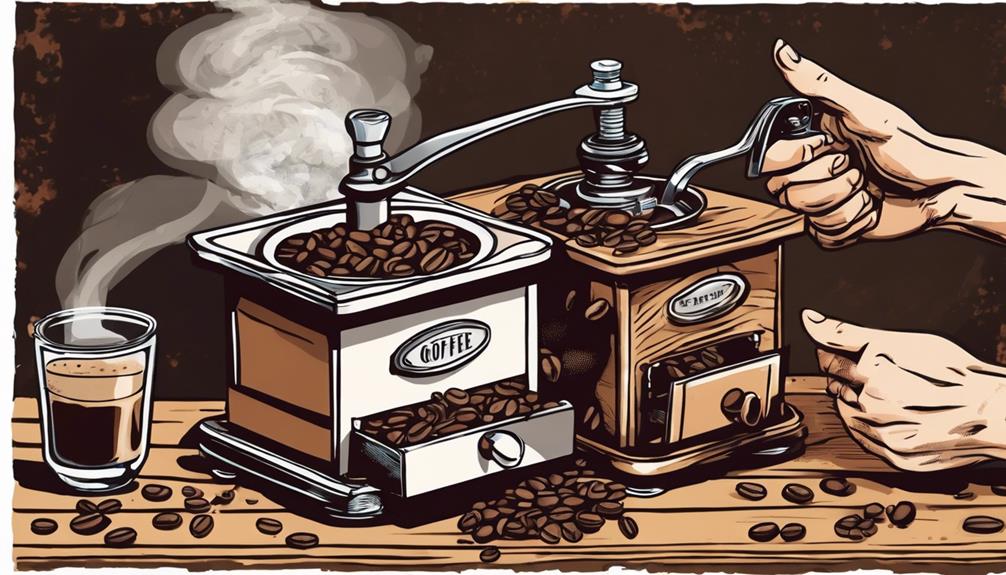
Enhancing durability and sustainability in homemade items is the primary focus of the Make It Resilient Challenge. When crafting your perfect cup of coffee for the challenge, consider incorporating elements that promote longevity and eco-friendliness.
Start by choosing a coffee recipe that aligns with the challenge's values. Once you have your preferred blend, mix well with plant-based milk to enhance the drink's resilience.
Participants in the Make It Resilient Challenge are urged to infuse their creations with innovative and long-lasting components. By taking part, you aren't only showcasing your creativity but also contributing to a more sustainable approach to crafting.
The challenge emphasizes thoughtful design and materials to bolster the resilience of homemade products.
Get creative with your coffee recipe, experiment with different plant-based milk options, and focus on crafting a drink that can withstand the test of time. Let your imagination flow as you mix your ingredients for a delicious and resilient homemade coffee experience.
Colors of the Rainbow Contest Info

The Colors of the Rainbow Contest focuses on participants creating vibrant and visually appealing food or drink recipes. Entrants are encouraged to incorporate a variety of colorful ingredients to represent the rainbow theme.
This contest likely includes judging based on creativity, presentation, and adherence to the rainbow theme. Participants may need to submit photos or videos showcasing their colorful creations for the contest.
It offers a fun and creative way to experiment with different ingredients and presentation techniques.
- Participants are encouraged to incorporate a variety of vibrant ingredients.
- The contest focuses on colorful creations representing the colors of the rainbow.
- Judging criteria likely includes creativity, presentation, and adherence to the rainbow theme.
Feedback and Comments on Recipe

Users praised the beaten coffee recipe for its depth, clarity, and taste, prompting engaging interactions with the creator, Dassana Amit. The positive feedback highlighted the satisfaction users experienced when beating the coffee, whether they preferred instant or non-instant coffee.
Dassana Amit's attentive engagement with users further enriched their experience, fostering a sense of community around the recipe. Users appreciated the ease of preparation and the exceptional quality of the coffee yielded by following the recipe.
Amit's prompt and appreciative responses to comments and feedback showcased her dedication to ensuring users' success in replicating the delicious beaten coffee. The interactions between users and the recipe creator not only enhanced the recipe's appeal but also created a welcoming environment where coffee enthusiasts could share their experiences and tips.
The feedback loop between users and Amit reflected a mutual passion for crafting the perfect cup of beaten coffee at home.
Frequently Asked Questions
How Do You Beat Coffee Without a Coffee Beater?
To beat coffee without a coffee beater, grab a whisk or fork. Whisk vigorously coffee, sugar, and hot milk for 5 minutes. Aerating the mixture by hand enhances flavor and aroma, giving you a cafe-style treat at home.
How to Make a Perfect Coffee?
To make a perfect coffee at home, you'll need high-quality coffee powder, hot milk, and powdered sugar. Beat the coffee mixture for at least 5 minutes for a creamy texture. Adjust ingredients to your taste preference.
How Do You Make the Perfect Cup of Coffee With Instant Coffee?
To make the perfect cup with instant coffee, mix it with sugar and hot milk. Beat it till creamy. Adjust proportions for your taste. The beating gives a cappuccino-like froth. Enjoy your homemade delight!
How to Make Beaten Coffee Without Sugar?
To make beaten coffee without sugar, mix coffee powder with hot water and milk. Use a natural sweetener like honey or maple syrup for a healthier option. Adjust sweetness to taste. Experiment with different types of milk for a personalized touch.
Conclusion
Now that you've mastered the art of beating coffee at home, you can enjoy a perfect cup every morning. Additionally, by perfecting your coffee-making skills, you have the option of choosing between tea and coffee each morning. This allows you to cater to your specific cravings or energy needs for the day. Whether you want a soothing cup of herbal tea or a robust and flavorful coffee, you can now start your day exactly how you want it.
Did you know that over 2.25 billion cups of coffee are consumed worldwide every day?
Keep experimenting with different flavors and techniques to find your favorite combination.
Cheers to delicious homemade coffee!

